Physical Address
304 North Cardinal St.
Dorchester Center, MA 02124
Cardiomyopathy is a general term used to describe a heterogeneous group of diseases that result in impairment of ventricular function. Clinical manifestations of these diseases can range from an asymptomatic state to heart failure, arrhythmias, or sudden cardiac death (SCD). Cardiac imaging, in particular echocardiography, plays a vital role in the diagnosis and management of affected individuals, and recently strain imaging has garnered great interest due to its superior ability to identify early functional abnormalities. In this chapter we will focus on the most common cardiomyopathies and on longitudinal strain (LS) in the affected chamber. This evidence has been gathered with left ventricular (LV) LS with the exception of arrhythmogenic right ventricular cardiomyopathy (ARVC).
Hypertrophic cardiomyopathy (HCM) is one of the most common genetic cardiovascular diseases with an estimated prevalence of 1:500 in the general population. It is caused primarily by mutations in genes encoding the sarcomeric contractile proteins. HCM is an inheritable disorder characterized by abnormal left ventricular hypertrophy (LVH), usually >15 mm, in a nondilated ventricle unexplained by causative afterload conditions. , If LV wall thickness is <15 mm, the diagnosis requires other features, including a confirmed positive family history of HCM, identification of a causative gene mutation, typical electrocardiographic (ECG) abnormalities, or other typical features on cardiac imaging. Individuals may also be genotype positive but phenotypically negative, meaning that although a causative gene has been identified, no morphologic abnormalities are noted on imaging. This is sometimes referred to as the “preclinical” phase of the disease but may persist throughout life in the case of incomplete penetrance. The identification of those with a gene mutation who will go on to manifest the disease is suboptimal. Occasionally, HCM can be challenging to differentiate from other causes of LVH such as infiltrative diseases (e.g., cardiac amyloid [CA] or Fabry disease) or physiologic LVH seen in athlete’s heart.
Although most individuals with the disorder have a normal life expectancy, the most feared complication is SCD. Risk stratification is a key component of the management of individuals with HCM, and implantation of a primary prevention implantable cardioverter defibrillator (ICD) is the treatment of choice in those at highest risk. Assessment of this risk remains imperfect and relies on multiple findings, including a family history of SCD judged to definitely or likely be related to HCM in a first-degree relative age ≤50 years, massive LVH with wall thickness ≥30 mm, unexplained syncope, nonsustained ventricular tachycardia (NSVT), with greater weight placed on more frequent (≥ 3), longer (≥10 beats) and faster (≥200bpm) runs of NSVT over 24 to 48 hours of monitoring, extensive late gadolinium enhancement (LGE) on cardiac magnetic resonance (CMR) imaging >15% of the LV mass, LV ejection fraction (EF) of <50%, and the presence of an LV apical aneurysm. The European Society of Cardiology recommends using a 5-year risk score based on a SCD risk calculator, which incorporates some of these risk factors but also includes age, left atrial (LA) size, and left ventricular outflow tract (LVOT) gradient, to make recommendations regarding ICD implantation. , There remains great controversy as to the optimal means of risk stratification. ,
Up to two-thirds of patients with HCM have LVOT obstruction either at rest or with provocation. Myectomy has traditionally been reserved for those with severe symptoms despite optimal medical management; however, newer data suggest that there may be a mortality benefit with early surgical relief of outflow tract obstruction. Identifying those who will benefit the most is therefore an area of great interest ( Central Illustration ).
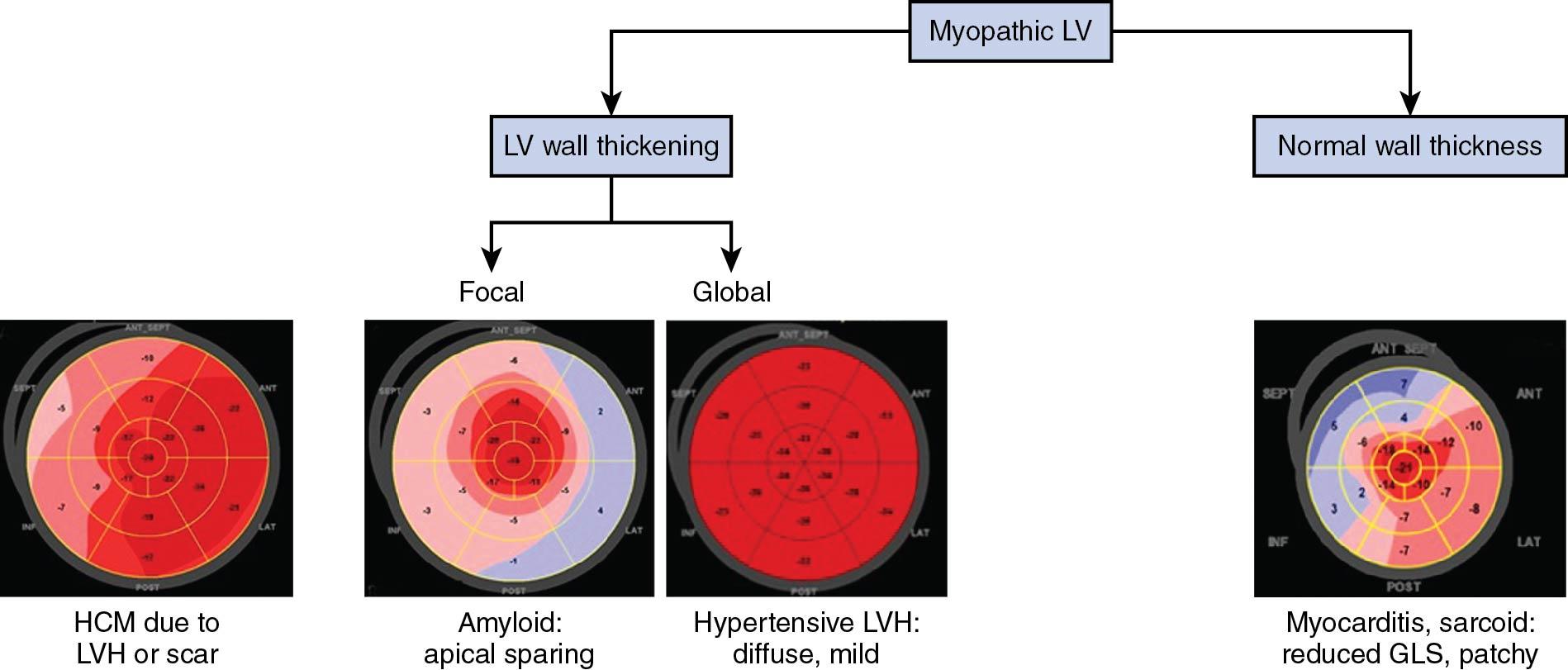
As discussed in other chapters in this book, LV global longitudinal strain (GLS) as assessed by speckle-tracking echocardiography can be used to detect subclinical disease. The question arises as to whether this tool can be used to identify HCM in gene-positive individuals prior to the development of hypertrophy. Regional deformation data have been shown to help in the differentiation of various causes of LVH, and we will review this in the context of HCM. Further, GLS has been shown to be highly predictive of outcomes in multiple disease states, and the question arises whether GLS can further refine risk assessment of SCD in HCM. Finally, we will review the potential role of GSL in identifying patients who will benefit from myectomy.
In 2006, Serri et al published the first study comparing strain in 26 patients with HCM with 45 healthy controls. They noted that all studied components of strain, including longitudinal, transverse, circumferential, and radial strain, were reduced in the HCM cohort compared with controls despite normal EF. The observation of a reduction in GLS despite normal LVEF in manifest HCM has been replicated in multiple studies since this initial observation, but literature describing the impact of HCM on global circumferential strain (GCS) has been more disparate. In 2008, Carasso et al followed up with a study of 72 subjects with HCM compared with 32 controls and confirmed the finding of reduced GLS, but in contrast to the study by Serri et al, demonstrated increased GCS in the HCM cohort ( Fig. 4.1 ). It appears contradictory that EF can be maintained despite a reduction in both GLS and GCS; however, a recently described analytic equation evaluating the relationship between EF and strain demonstrated that although GCS contributed more than twice as much to EF, EF could be maintained with increased wall thickness or reduced diameter despite reduction in both GLS and GCS. Therefore, although reduced GLS is a uniform finding in HCM, impact on GCS can be variable, and it is theoretically possible that EF could be normal despite reduction in both GLS and GCS. Differences seen in other strain parameters between studies may be related to differing severity of disease, different techniques and vendors employed, and many other parameters known to influence strain such as age and afterload conditions.

LV geometry, specifically hypertrophy, is a major contributor to reduced strain. , Tadic et al demonstrated a gradual reduction in all strain parameters with increasing severity of LVH in 197 hypertensive patients with normal EF. In a study of 39 consecutive patients with HCM, Popovic et al found that segmental wall thickness was a significant predictor of reduced segmental longitudinal strain in a multivariable analysis ( Fig. 4.2 ). However, although circumferential deformation and rotation decline after myectomy or alcohol septal ablation, they do not normalize, suggesting that observed reductions are not exclusively attributable to hypertrophy ( Fig. 4.3 ). , Indeed, Popovic et al also reported that mean end-systolic longitudinal strain also correlated with the number of fibrotic segments and total myocardial fibrosis. Fibrosis, along with wall thickness, was an independent predictor of lower segmental longitudinal strain. This work was corroborated by Chang et al who also found that wall thickness and LGE were significant predictors of GLS on 40 patients with HCM. LGE is thought to primarily detect replacement fibrosis of the myocardium rather than interstitial fibrosis. GLS may be more sensitive than CMR imaging in detecting interstitial fibrosis when compared with histopathology obtained from septal myectomy tissue. In summary, both the degree of wall thickening and severity of fibrosis correlate closely with regional strain and, in turn, global strain.
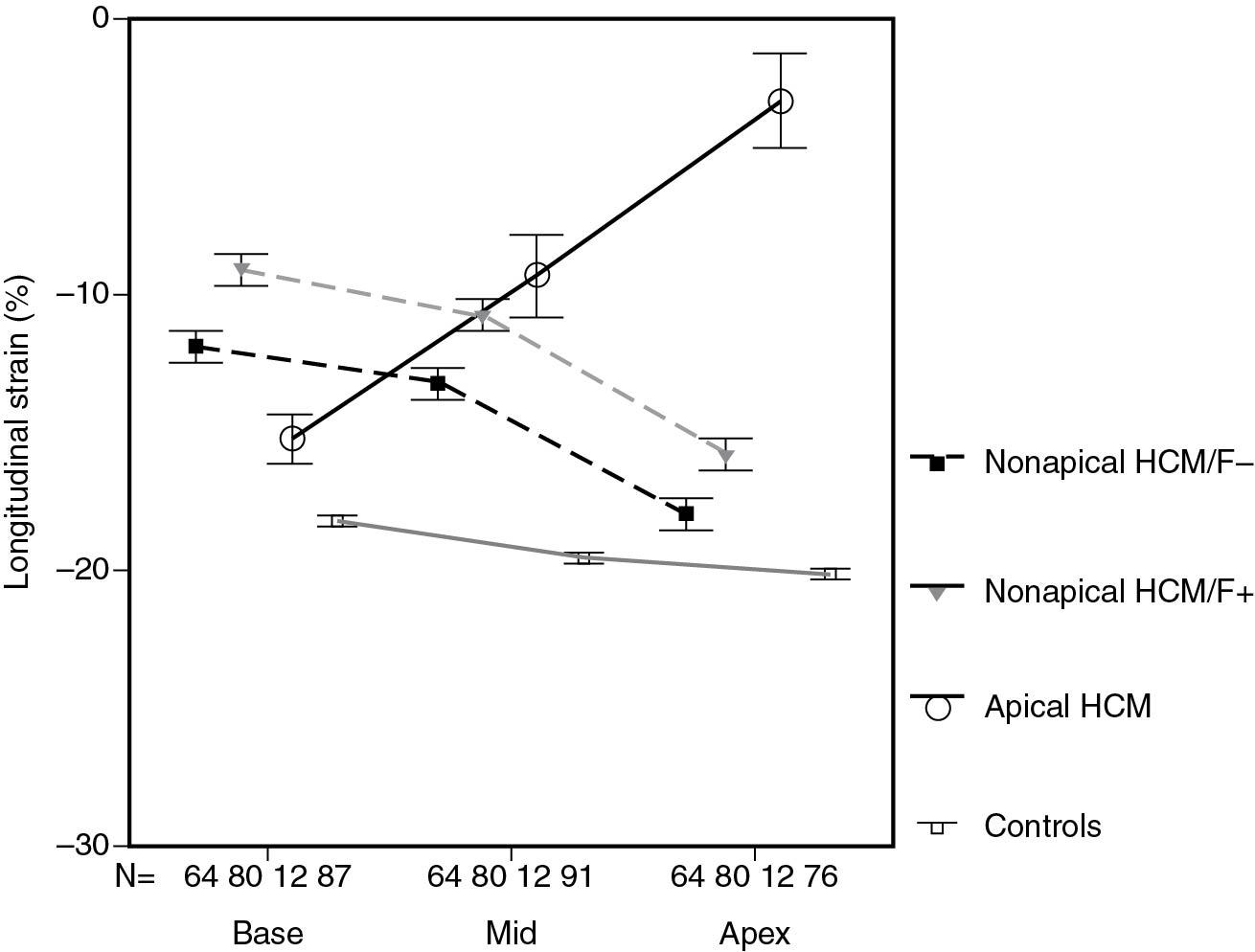

Based on the observations described earlier, it is not surprising that there are typical regional variations in LS based on the location of the asymmetric hypertrophy and fibrosis in HCM ( Fig. 4.4 ). In patients with basal septal HCM, the reduction in strain is most prominent in the basal segments with a resultant exaggeration in the expected base-to-apex gradient ( Fig. 4.5 ; Video 4.1 ). The reverse in seen in apical HCM in which the bull’s-eye strain pattern is reminiscent of a left anterior descending artery (LAD) infarct with regional reduction of apical strain (see Fig. 4.5 ; Video 4.2 ). ,

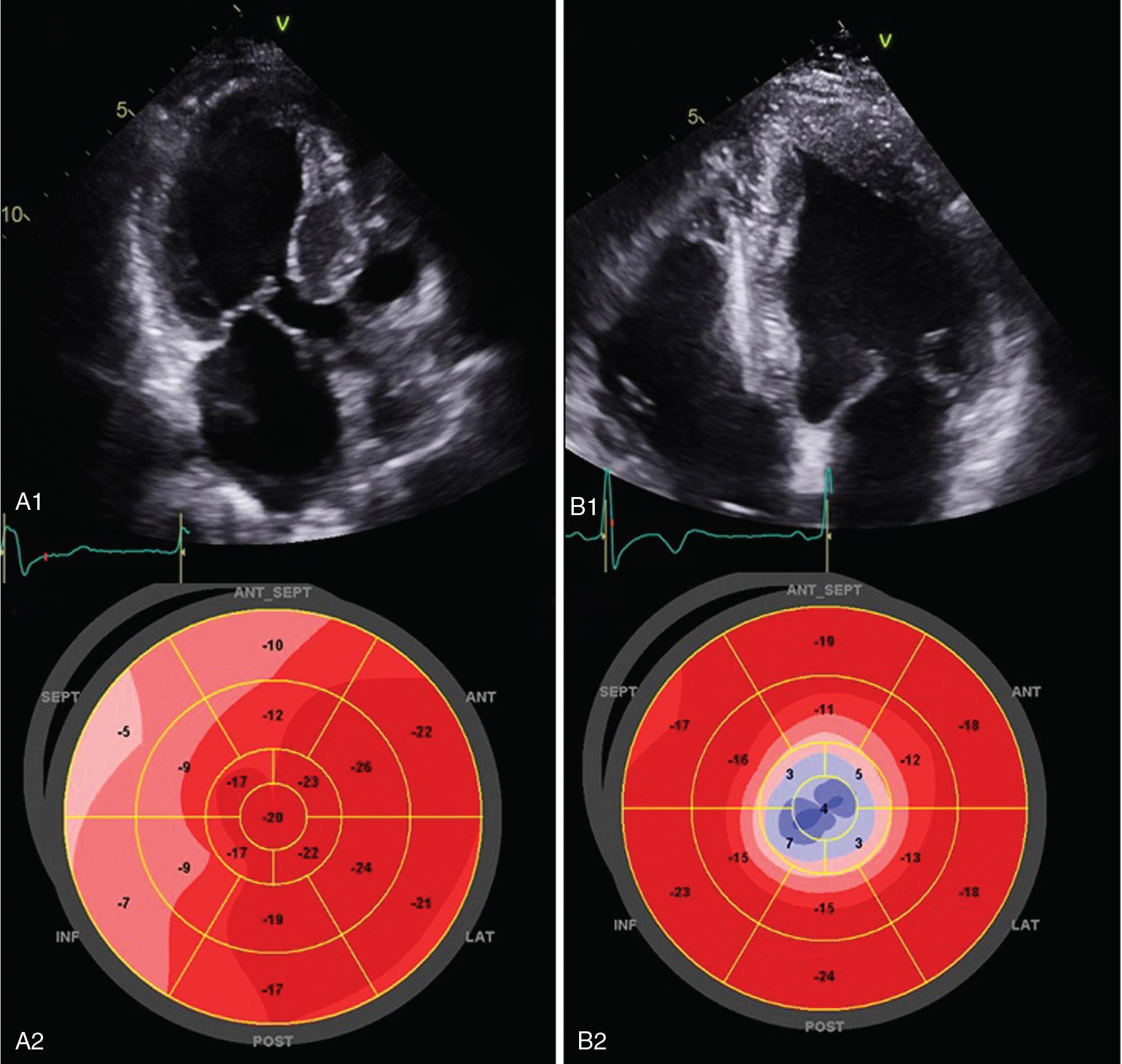
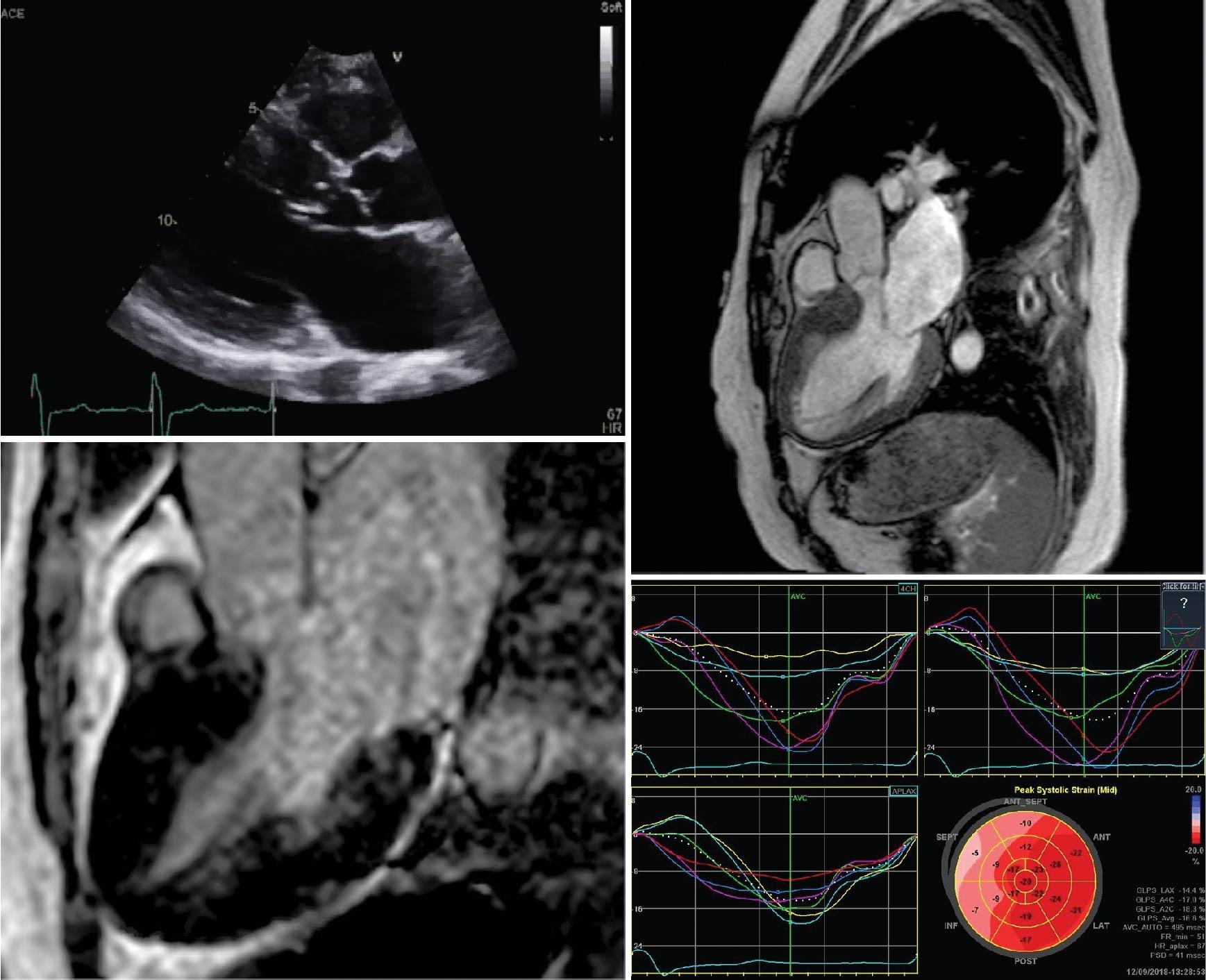
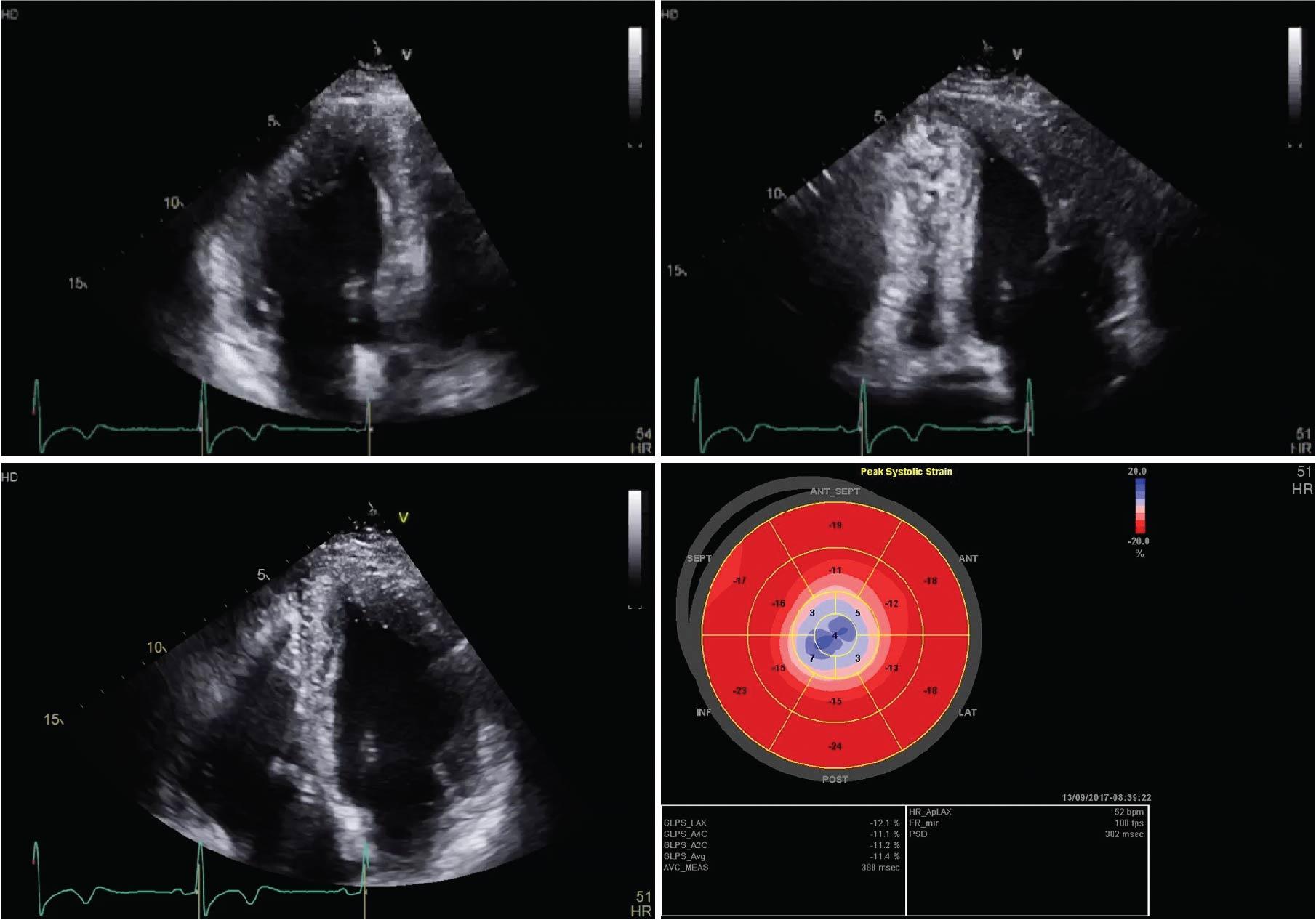
Sun et al first looked at the ability of GLS to differentiate HCM from other causes of LV wall thickening. Circumferential, longitudinal, and radial strain were noted to be lower in HCM compared with normal controls and individuals with LVH related to increased afterload (hypertension or aortic stenosis) but was not as low as strain parameters in the amyloid group. The lack of specificity of this finding limited its application into clinical practice. Subsequent work has focused on the regional patterns of strain to aid diagnosis.
Overt HCM with severe hypertrophy is rarely a diagnostic challenge, and use of novel echocardiographic techniques is seldom necessary; however, this may not be the case in the early stages of phenotypic expression. A study from the Cleveland Clinic evaluated the use of GLS patterns to aid diagnosis in patients with mild to moderate LVH without typical ECG changes. Twenty-four consecutive studies were selected (8 HCM, 8 CA, and 8 hypertensive heart disease [HHD]) with mild to moderate LVH and no ECG changes. Twenty level 3–trained readers were asked to provide the most likely diagnosis on two separate occasions. During the first session, two-dimensional (2D) echocardiographic images and diastolic parameters were provided alone, and during the follow-up session, the same parameters were provided in addition to the strain polar map. The addition of the strain polar map significantly improved the specificity ( P =.01) and accuracy ( P <.01) of diagnosing HCM. Regional reductions in strain with even mild asymmetric hypertrophy should therefore raise the suspicion for early manifestation of HCM.
HCM has been reported as the most common cause of SCD in young athletes. Regular intense exercise results in electrical, morphologic, and functional changes in the heart commonly referred to as an athlete’s heart (AH). A common manifestation is increased LV wall thickness. Rarely, it can be exceptionally challenging to differentiate HCM from an extreme manifestation of AH, particularly in black athletes, in whom up to 18% have LV wall thickness of >12 mm. GLS has been proposed as a tool to distinguish these entities. These studies are limited for two reasons: First, the HCM groups are usually easily distinguishable by their significantly increased septal wall thickness compared with athletes; second, they compare healthy athletes with sedentary patients with HCM. There is an increasing appreciation that some individuals with HCM can be high-level athletes with significantly better myocardial functional parameters than sedentary patients with HCM. Only one study to date has evaluated the utility of strain to differentiate healthy athletes with LVH from athletic individuals with HCM and comparable LV wall thickness (true grey-zone cases). Consistent with prior studies, the sedentary HCM group had reduced strain; however, no difference was seen in GLS at rest between the athletic HCM cohort and the athletes without HCM. They did note two differentiating factors: The first was a reduction in exercise GLS ( Fig. 4.6 ), and the second was an increase in mechanical dispersion between athletes with and without HCM. These data need to be replicated.
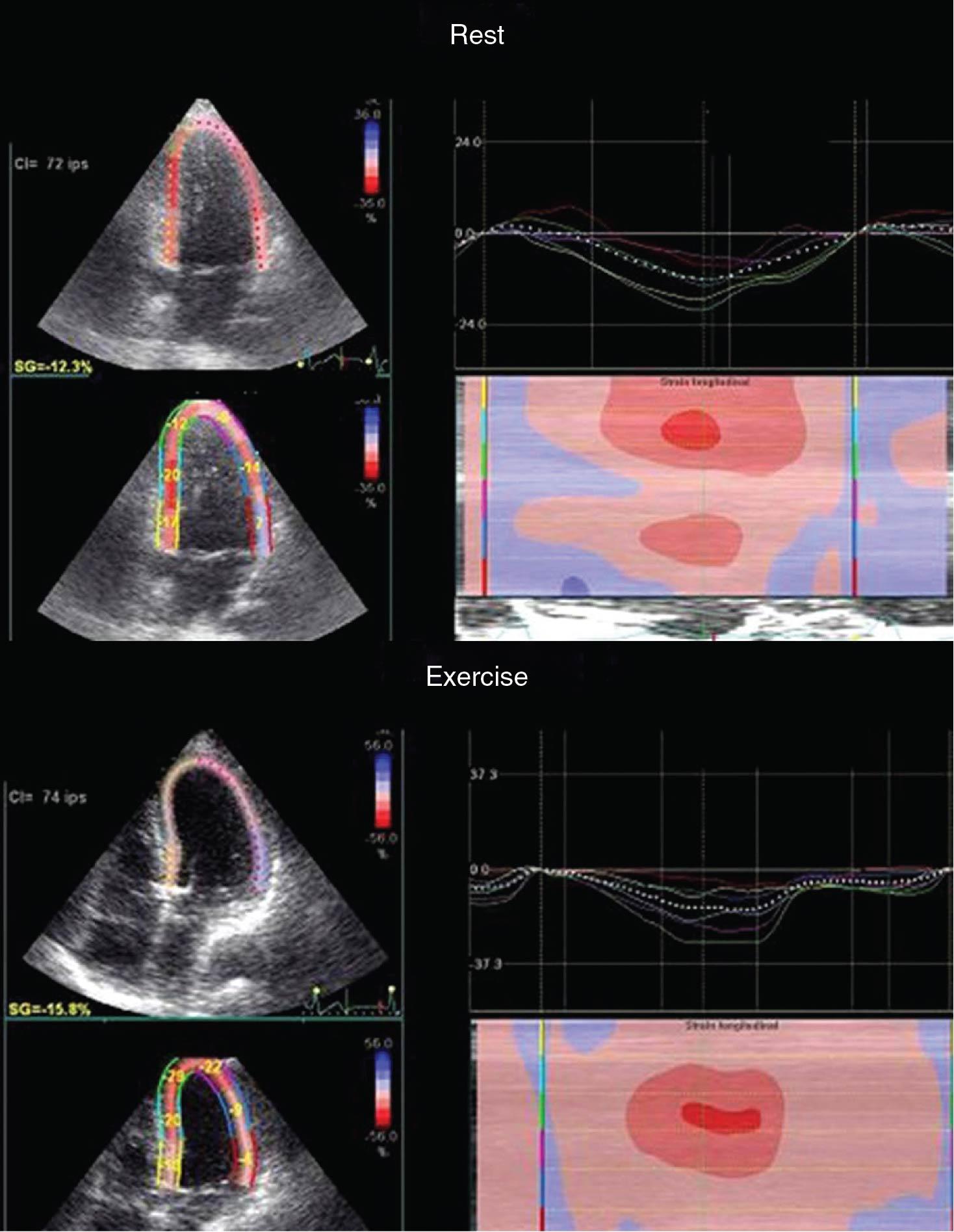
Phenotypic expression of HCM may be delayed for decades in gene carriers. The age at which penetrance develops is variable and may occur up until about the age of 60 years. This has resulted in recommendations for ongoing screening throughout adult life in family members of gene-negative individuals with HCM. , The preclinical phase in gene-positive individuals has been associated with subtle changes in myocardial structure and function without overt hypertrophy. , Identification of early changes may help identify a subgroup that is more likely to progress early and therefore may benefit from more frequent screening. It may also provide a marker for evaluation of novel therapies designed to halt the progression of disease. Given the ability of GLS to identify systolic dysfunction prior to a drop in LVEF, many investigators have evaluated GLS in identifying changes in the preclinical phase of the disease. The original study evaluating this question was performed in 2009 by Ho et al who compared 68 preclinical gene-positive individuals with 40 patients with overt HCM and 38 normal controls. No difference in GLS was noted between the preclinical HCM and the normal controls, but GLS was significantly reduced in overt HCM. This finding has subsequently been replicated by others. However, in contrast to Ho et al’s original paper these subsequent papers consistently found regional differences in strain—specifically, a reduction in strain at the basal septum in preclinical HCM. Each of these studies had small numbers, and there was a nontrivial overlap in the strain values between the preclinical cohort and normal controls. However, this consistent finding in multiple independent laboratories suggests that this may be a clinically meaningful parameter in the future.
The literature to date evaluating the prognostic role of GLS in HCM is presented in Table 4.1 . Three studies evaluated the association of GLS with ventricular arrhythmias and ICD discharge alone. The first study to evaluate this association, published by Di Salvo et al in 2010, used 24-hour Holter monitoring to follow 93 patients every 3 months for 2 years. GLS was not included in the multivariable model, but they noted that the presence of more than three LV segments with a LS value of worse than −10% was an independent predictor of NSVT ( Fig. 4.7 ). This study was followed by a study by Debonnaire et al., who studied 92 HCM patients and noted that GLS was an independent predictor of ICD discharge on multivariable analysis. Indeed, GLS showed a higher accuracy of predicting appropriate ICD discharge than the presence of conventional SCD risk factors (area under the curve 0.65 (95% confidence interval {CI} 0.54–0.77) versus 0.52 (95% CI 0.43–0.58, P <.001). In 2018, Canden et al described comparable findings in a study of 63 HCM patients reporting that GLS independently predicted appropriate ICD discharges.
| First Author | Year Published | Patients ( n ) | Vendor (Software) | Follow-up | Average GLS for HCM | Endpoint | Major Findings |
|---|---|---|---|---|---|---|---|
| Paraskevaidis et al | 2009 | 50 | GE (EchoPac) | 12 months | −14 ± 4 | Death and hospitalization | Strain predicted worse outcomes in univariate but not multivariate analysis. |
| Di Salvo et al | 2010 | 93 | GE (EchoPac) | 2 years | −15.95 ± 3.24 | NSVT | Patients with NSVT had lower basal and midwall regional strain; >3 segments with peak LS of ≥−10% was predictive of outcome. |
| Saito et al | 2012 | 48 | GE (EchoPac) | 42 ± 12 months | −12.7 ± 2.9 | SCD, fatal arrhythmia, hospitalization for CHF | Significantly more events in those with GLS less than median (−12.9%). |
| Funabashi et al | 2013 | 44 | Philips (Qlab) | 18 months | −9.89 ± 2.59 | Cardiac death, syncope, sustained VT/VF, appropriate ICD discharge | Worsening GLS associated with worse outcomes. GLS significantly worse in subjects with MACE than in those without MACE (−8.2 ± 2.0% and −10.6 ± 2.5%, respectively, P <.001). |
| Debonnaire et al | 2014 | 92 | GE (EchoPac) | 4.7 years | −13.3 ± 3.5 | Appropriate ICD therapy | GLS was an independent predictor of appropriate ICD therapy on multivariate analysis. GLS ≥−14% associated with worse outcome. |
| Reant et al | 2015 | 115 | GE (EchoPac) | 19 ± 11 months | −16.6 ± 3.6 | Death, sustained VT, appropriate ICD discharge, progression to NYHA class III/IV | Cox backward-entry selection model revealed that GLS ≤ 15% at rest was independently associated with an increased risk for poor outcomes. |
| Hartlage et al | 2015 | 79 | GE (EchoPac) | 22 months | −14.3 ± 4.2 | Death, sustained VT/VF, hospitalization for CHF | GLS worse than −16% associated with worse outcome. |
| Reant et al | 2016 | 472 | GE (EchoPac | 4.3 years | −15.4 ± 3.7 | Cardiovascular death, appropriate ICD discharge, hospitalization for CHF | GLS was significantly associated with the endpoint (HR 0.90, 95% CI 0.83 – 0.98, P =.018). |
| Ozawa et al | 2017 | 41 | Philips (Qlab) | 30 months | NA | Death, sustained VT/VF, appropriate ICD discharge, hospitalization for CHF | GLS was a predictor or MACE. Best cutoff of −9.65% on ROC curve gave a sensitivity and specificity for MACE occurrence of 100% and 64.7%, respectively. |
| Candan et al | 2017 | 63 | GE (EchoPac) | 21.5 ± 6.9 months | −12.1 ± 3.4 | Appropriate ICD discharge | Mechanical dispersion and GLS were found to be independent predictors of occurrence of appropriate ICD therapy. |
| Moneghetti et al | 2017 | 131 | Philips (Qlab) | 56 months | −14.3 ± 3.9 | Death, worsening HF, hospitalization for CHF, heart transplantation | GLS was predictive of outcome on univariate analysis but not multivariate analysis. The worst outcomes were observed for patients with lateral LS <16.1%. |
| Liu et al | 2017 | 400 | GE (EchoPac) | 3.1 years | −16 ± 4 | Death, heart transplantation, sustained VT/VF, CHF | Patients with GLS >−16% had significantly more events (17% vs 7%, P = .002). Event-free survival was significantly superior in those with GLS ≤16% vs GLS >−16% ( P =0.004). GLS was significantly associated with the composite endpoint on multivariate analysis. |
| Hiemstra et al | 2017 | 427 | GE (EchoPac) | 6.7 years | −15 ± 4 | Death, heart transplantation, appropriate ICD discharge | Multivariable Cox regression analysis revealed GLS to be independently associated with the primary endpoint (HR GLS 1.10 [1.03−1.19], P =.007). |
| Tower-Rader et al | 2017 | 1019 | Philips, GE, Siemens (Velocity vector imaging) | 9.4 ± 3 years | −13.7 | Death or appropriate ICD discharge | 61% of events occurred in patients with GLS worse than median (−13.7). Subhazard ratio for every % worsening of GLS was 1.11 (1.05–1.220) P <.001. |
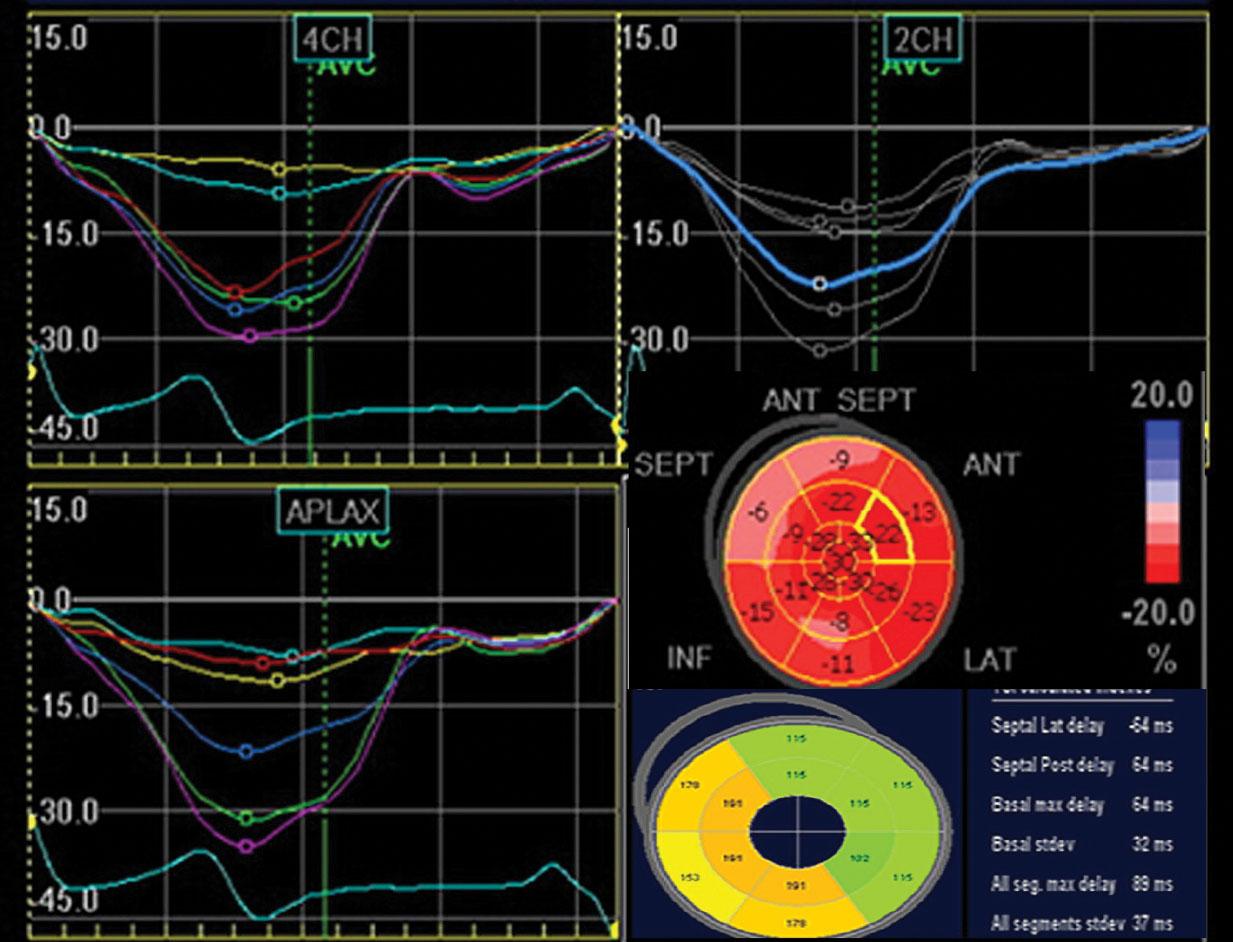
Eleven studies have evaluated the association between GLS and death with nine studies, including a combination of congestive heart failure (CHF) readmission, all-cause readmission, worsening heart failure, syncope, or cardiac transplantation as part of a composite outcome definition. There was a large variation in annualized event rates between studies (between 0.7%/year and 40%/year) based on the outcome definition. One common thread in all of these studies was that GLS was significantly associated with the primary outcome on univariable analysis, and four of five studies that employed multivariable analysis reported a significant association between GLS and outcome. , , , , The one study that did not show a statistically significant association used analysis on an apical four-chamber view only and therefore is not reflective of true GLS. The thresholds used to define risk varied greatly between studies and were based on either reports from prior studies, median values, or receiver operator curve analysis. These values ranged from −9.64% to −16%.
The heterogeneity in studied cohorts and clinical outcomes, incomplete definition of baseline risk, in particular the presence or absence of obstruction, and variability in thresholds used to define risk all limit the utility of GLS as a means to further refine current risk models in HCM at this time.
Only one study evaluated the interaction between GLS and myectomy. Tower-Rader et al followed 1019 patients with obstructive HCM (maximum LVOT gradient ≥30 mm Hg) over 9.4 ± 3 years. Their median resting GLS was −13.7%. The primary outcome was a composite of cardiac death and appropriate ICD discharge, and 20% of patients underwent myectomy over the follow-up period. Subjects were divided into four groups based on median GLS values and surgery. Based on the finding that the cohort with GLS less than median who did not undergo myectomy had significantly worse outcomes, the authors suggest that GLS may be useful to define an at-risk cohort. In addition, a small proportion with severely reduced GLS of worse than −7% had worse outcomes despite myectomy.
Become a Clinical Tree membership for Full access and enjoy Unlimited articles
If you are a member. Log in here